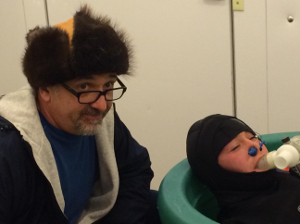|
Warren, Michigan — Jan 22, 2015 — In an article published by the U.S. Naval Surface Warfare Center, Coliant's success for the production of a self-contained thermal protection dive suite was acknowledged.
Understanding the advantages of warming the body using FAR Infrared wave lengths, the U.S. Navy researchers utilized Coliant's existing Carbon Nano-Core fiber technology. Using Coliant's technology along with their expertise in heated gear, the two entities were able to develop a prototype polypropylene long underwear capable of keeping a human body warm in 40°F water. The garment was tested in what most would call severe conditions but what many men and women in the military face everyday. Several laboratory tests were conducted with the garment this past September and came off with great success.
We're proud to be working with the U.S. Navy on such an important project. said Coliant President John Swiatek. Our engineers work long and hard to make sure our servicemen & women can operate in such harsh environments. We at Coliant look at this as some of the most important work we do.
Coliant has been in cooperation with the Department of Defence for several years and see great opportunities with this as well as other technologies currently under development in Coliant's research laboratories.
NSWC PCD, ONR and U of MT Conduct Heated Undergarment Technology Evaluation Program
By John P. Klose,
Underwater Systems Development and Acquisition Branch (Code E15), Naval Surface Warfare Center Panama City Division
PANAMA CITY, Fla Naval Surface Warfare Center Panama City Division (NSWC PCD) researchers have demonstrated a breakthrough diver thermal protection technology that can warm divers indefinitely in very cold water using four to six times less power than previously designed systems.
The Office of Naval Research (ONR) funded research primarily conducted at NSWC PCD in Panama City, Florida this past year, identified the safe and highly-efficient, electrically-heated, diver thermal undergarments using Carbon Nano Core fibers, or CNC, are effective. The next step is to transition this technology into both dry and wet cold environment applications and develop mission-specific prototype garments for further testing.
The technology was developed through a collaborative ONR Swampworks research effort between NSWC PCD, the University of Montana Center for Work Physiology and Exercise Metabolism (WPEM), and defence contractors SAIC and the Coliant Corporation.
The U.S. Navy in Panama City, Florida has been investigating diver thermal protection technologies since the SEALAB experiments in the 1960s. Since salt water freezes at a lower temperature than fresh water, ocean temperatures in winter can reach as low as 29°F creating a very challenging environment in which Navy divers must operate. Cold skin temperatures lead to a loss of muscle strength and the ability to manipulate tools. Continued exposure to cold water can lead to the loss of core body temperature, called hypothermia, which can cause death in extreme situations. Navy divers are consistently challenged when working in cold water whether the mission is neutralizing mines, changing out the propeller of a ship, or riding in a SEAL Delivery Vehicle.
We are very excited about the initial results of our investigation, said NSWC PCD Project Engineer John Klose. Coliant CNC fibers have the right combination of physical, thermal, and electrical properties that allow us to build an electrically-heated undergarment that would not be possible using traditional technologies. The biggest risk from previous designs of electrically-heated diver thermal protection suits has been the potential for hot spots within the suit that could burn the diver. These new fibers use less power and generate heat at a lower overall temperature than traditional technologies. This allows us to design a diver heated undergarment that is much safer and much more energy efficient than previous diver heating system designs. We are seeing no change in the metabolic rate of test subjects dressed in the heated undergarment and dry diving suit ensemble and sitting passively in a test tank filled with 40°F water, says Dr. Brent Ruby, Director of University of Montana WPEM. Their average skin and core body temperatures are normal and hold steady with less than 50 Watts of power being applied to the prototype undergarments. Without this protective heated diving suit ensemble, a normal person would survive less than 20 minutes in such cold water.
Having a safer and more energy efficient design solution for heated clothing can greatly improve the military performance in many operational missions that are conducted in extreme environments, says Coliant President, John Swiatek. Soldiers trekking through mountain passes, helicopter air crews in the North Atlantic in January, ground crew on a wintry airfield, or sailors working on aircraft carrier flight deck must all deal with harsh, cold weather environments. This technology even has application in combat casualty care for preventing or delaying the onset of shock and potentially extending what is known as the golden hour.
NSWC PCD has been the U.S. Navy Center of Excellence for Diving Systems and Technology for over 60 years. This latest breakthrough tackles one of the toughest challenges that Navy developers have faced in creating a safe and energy efficient heating source for Navy divers. Its future application to various Navy operational needs like ship husbandry, Initial Response Diving operations, arctic warfare, and Special Warfare operations is expected to greatly improve human performance in these applications.
Naval Surface Warfare Center Panama City Division
Technical Center of Excellence for Littoral Warfare and Coastal Defense
http://www.navytimes.com/story/military/tech/2015/01/20/navy-thermal-undergarments-diving-suits-onr/22003111/
Navy Times Article
Press Contact:
Carl Peterson
Powerlet LLC
586-210-0330
NOTE TO EDITORS: For additional information visit Powerlet's PR website, or call Powerlet at 586-210-0330.
Powerlet, the Powerlet logo, RapidFire and Luggage Electrix are trademarks of Powerlet LLC. Other company and product names may be trademarks of their respective owners.
###
|



